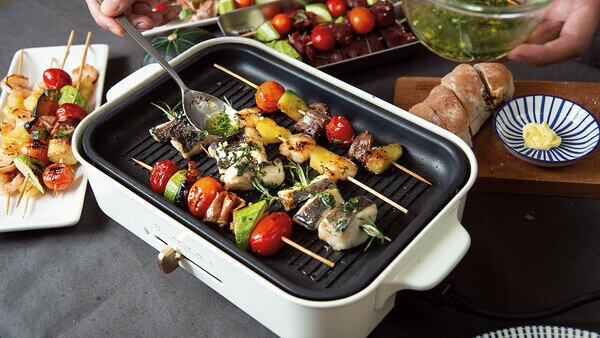Multi-functional electric hot plates were all the rage for a time when they first hit the market because of their readily assorted set of multi-purpose plates and deep pots for cooking, plus an appealing design in different colours. The Consumer Council has put to test 9 models of this cookware, and the results showed none of the samples could pass all 8 safety items in the test. In particular all samples were found in exceeding the limit of the standard in temperature rise, and 8 with inadequate insulation distance in which 2 recorded excessive leakage current, posing increased risks of short circuiting and electric shock. Furthermore, the test revealed variations among the samples in pre-heating and heat distribution performance. Consumers should choose with care both the safety and performance of the product and follow closely the operation instructions when in use.
Consumers should take heed that while electric hot plates may look very attractive, their overall test performance was rather average. On a scale of 5, only 1 sample with the highest priced near $1,000 could score a relatively high rating of 4 points, while 2 other samples priced at about $600 and $700 performed poorly in safety test and rated with only 2 points overall, for the 6 remainders scored 3 points.
The 9 test models were priced over a range of $599 to $998, and except for 1 sample with a rated power of 650W, the remainders were between 1,200W and 1,300W. All samples came with 2 to 4 plates, some samples also provided options of additional plates or accessories for users to purchase. The test focused on 2 parts, performance and safety. The safety test was conducted in reference to the latest international standards IEC60335-1, IEC60335-2-9 and/or IEC60335-2-15, including insulation and abnormal operation, protection against access to live parts, temperature rise, power input, markings and instructions, etc. The results were disappointing, no samples could pass all safety test items.
In the test of temperature rise, all samples exhibited excessive temperature rise above the standard upper limit in some parts of the appliance (for instance, the handle of the lid, the pins of the appliance inlet, the on-off switch and/or internal wiring, etc). In the test, the measured temperature rise of surfaces of 2 samples were 81.5K and 71.1K respectively, but in the absence of high temperature warning symbol they were deemed to be non-compliant on the standard of safety requirement.
2 other samples when operated under the condition of 1.15 times of the rated power input, the leakage current measured between the current-carrying parts and the earthed internal metal case were 5.55mA and 7.97mA, which were much higher than the standard upper limit of 0.75mA, increasing the risk of short circuit and electric shocks during use. When the latter sample with higher leakage current was subjected to condition of 1.24 times of the rated power input in an abnormal operation test, the current generated was so large that activated the miniature current breaker, putting the sample unable to continue the test.
On protection against access to live parts, non-compliance was detected in 7 models, in which 5 models fitted with magnetic connectors. If they are plugged in a tilted position, which the earthing conductor was not first connected, possible contact with the live parts in the socket may be resulted. The Council urged the traders to improve the protection of electric shock and the design in earthing provision.
For the performance test regarding grilling, heat distribution and pre-heating, considerable temperature variation was found among the samples after pre-heating. The results showed the average highest pre-heating temperature of the models vary from 117°C to 194°C, with a discrepancy of 77°C. The highest pre-heating temperature discrepancy recorded on the models at different positions of the plates ranged from 35.4°C to 61.1°C, with the highest pre-heating temperature discrepancy in 2 of the samples by more than 60°C, reflecting the temperature distribution is uneven.
To evaluate the evenness in heat distribution, the heat distribution of the models was judged by surface browning and evenness of the cooked food. Since the cooking temperature of the individual sample was regulated automatically by the thermostat, on the flat plate where positions are closer to the heating element are relatively hotter, therefore the grilling or frying effect on the food was affected. The overall test result in this aspect for the models was fair.
On grilling performance, the results showed patty of 1 model with relatively uneven browning, and in 2 models with a difference between the maximum and minimum centre temperatures exceeding 10°C, the performance was inferior.
Consumers using multi-functional electric hot plates should heed the following:
- Read the user manual carefully, follow the instructions on pre-heating procedures; in the case of some models, the use of the lid is not recommended during heating;
- When cooking, should avoid touching the appliance surface as it could be quite hot, and never allow children to use or touch unattended to avoid scald injury. As the metallic lid surface could rise to a very high temperature, care should be taken to use a dry cloth or heat insulation gloves to lift the lid. The user manuals of some models recommend users to use lid only with specific plates (such as the deep pot);
- Avoid using metallic instruments in cooking, products with wooden or silicone material were recommended, and do not use wire brush to clean the plates to prevent scratching off the non-stick coating;
- When stacking up multiple plates and lids for storage, use a soft cloth to separate each one of them to protect the non-stick coating against scratching.
The Consumer Council reserves all its right (including copyright) in respect of CHOICE magazine and Online CHOICE.




